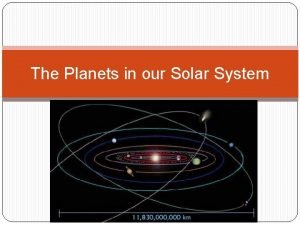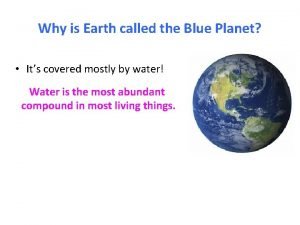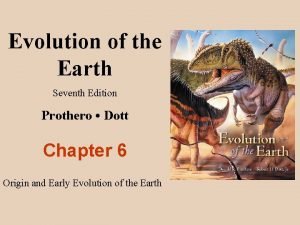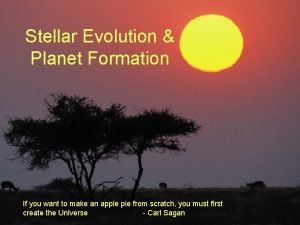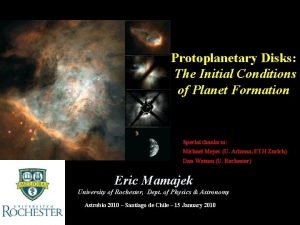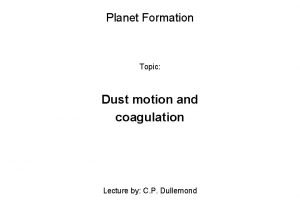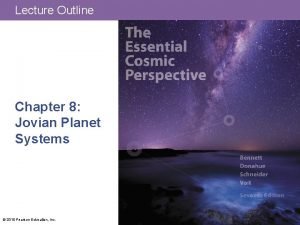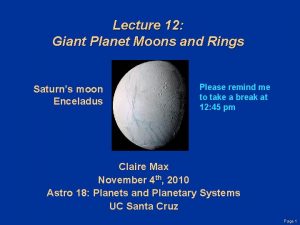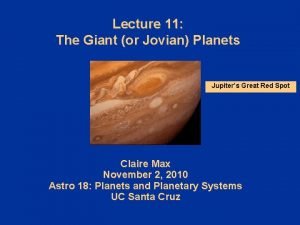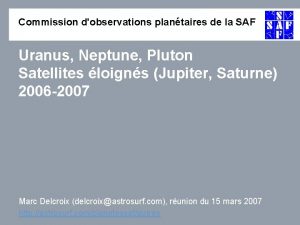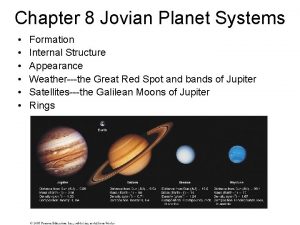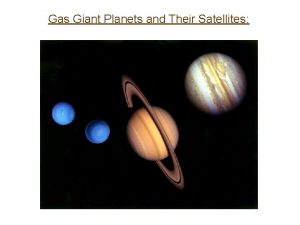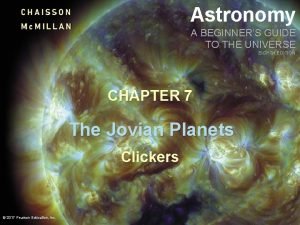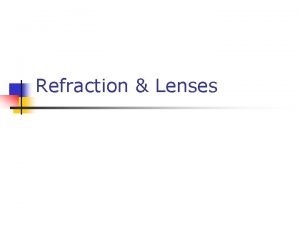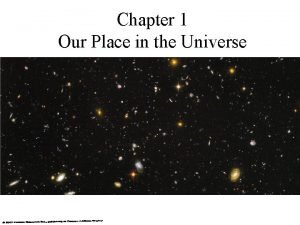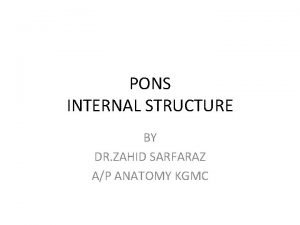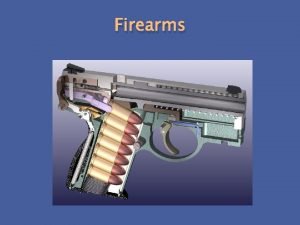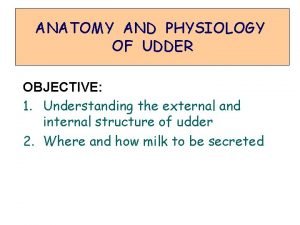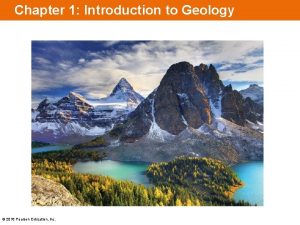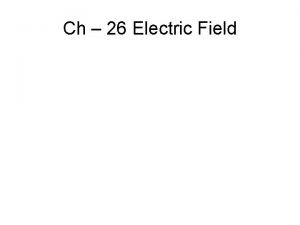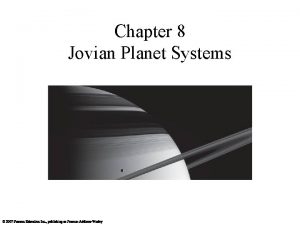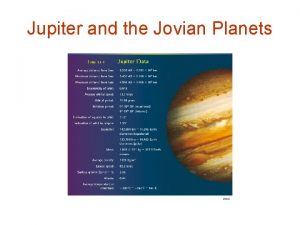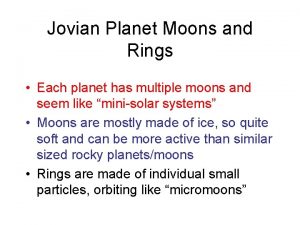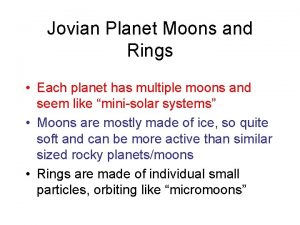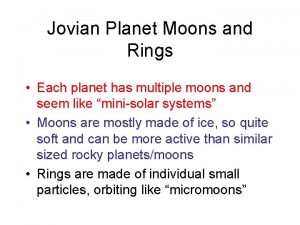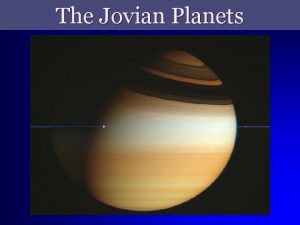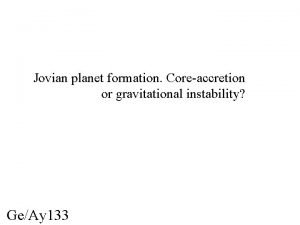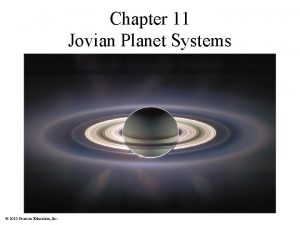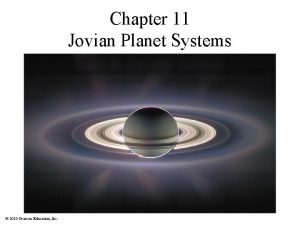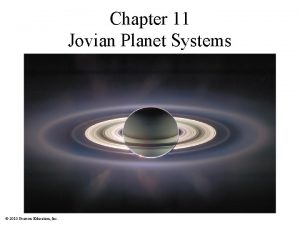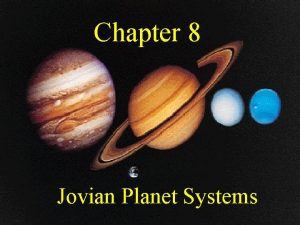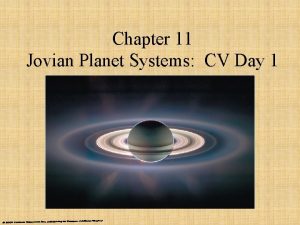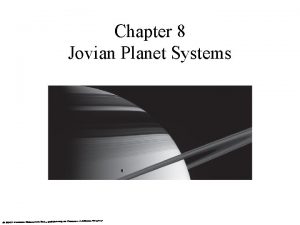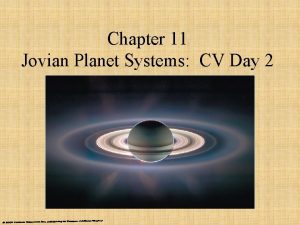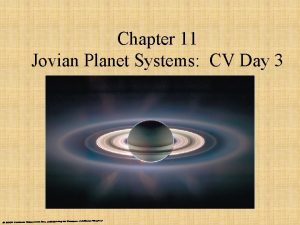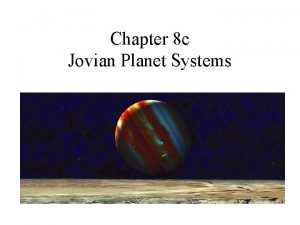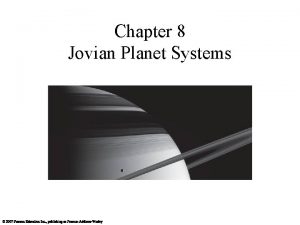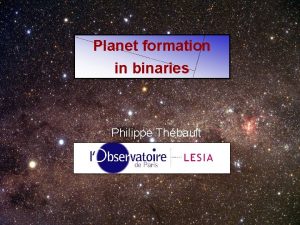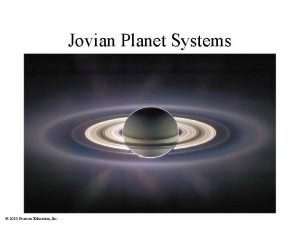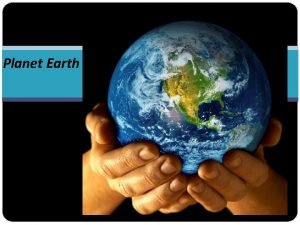Chapter 8 Jovian Planet Systems Formation Internal Structure


![Physical Parameters of The Jovian Planets Hydrogen & Helium [by mass] Others Materials [by Physical Parameters of The Jovian Planets Hydrogen & Helium [by mass] Others Materials [by](https://slidetodoc.com/presentation_image/44a1628e681ee0183231e7c37a83acf1/image-3.jpg)

![Physical Parameters of The Jovian Planets Hydrogen & Helium [by mass] Others Materials [by Physical Parameters of The Jovian Planets Hydrogen & Helium [by mass] Others Materials [by](https://slidetodoc.com/presentation_image/44a1628e681ee0183231e7c37a83acf1/image-5.jpg)


































- Slides: 39

Chapter 8 Jovian Planet Systems • • • Formation Internal Structure Appearance Weather---the Great Red Spot and bands of Jupiter Satellites---the Galilean Moons of Jupiter Rings

Overview: Similarities and Differences The jovian planets can be roughly divided into two groups: • Jupiter and Saturn are similar in size (large, ~ 10 Rearth), with similar reddish and brownish color. • Uranus and Neptune are smaller in size (~ 4 Rearth), with similar bluish color.
![Physical Parameters of The Jovian Planets Hydrogen Helium by mass Others Materials by Physical Parameters of The Jovian Planets Hydrogen & Helium [by mass] Others Materials [by](https://slidetodoc.com/presentation_image/44a1628e681ee0183231e7c37a83acf1/image-3.jpg)
Physical Parameters of The Jovian Planets Hydrogen & Helium [by mass] Others Materials [by mass] Mass [Mearth] Size [Rearth] Density [g/cm 3] Distance to Sun [AU] Jupiter: ~97% ~3% 318 11. 2 1. 33 5. 2 Saturn ~90% ~10% 95 9. 5 0. 71 9. 5 Uranus ~30% ~70% 14 4. 0 1. 24 19. 2 Neptune ~30% ~70% 17 3. 8 1. 67 30. 1 General Trend… • The distance of the planets (w. r. t Sun) roughly determines their final mass and size. • The closer to the Sun, the more materials to accrete to form larger planet. • Planets that are closer to the Sun probably grew the fastest. • Planet formation process ends at the same time for all the planets, when solar wind started and cleared the planetary nebula.

Formation of the Jovian Planets At location far from the Sun, beyond the frost line, there are plenty of ice-rich planetesimals. • The Jovian planets are thought to form from ice-rich planetesimals of about the same mass---roughly 10 times the mass of the Earth. • The high mass and their strong gravity allow them to draw in large amount of hydrogen and helium gas, and keep them (remember that light gases are more difficult to keep on planet surface). • The icy component makes up a larger fraction of the mass for planets farther away from the Sun. The density of the Jovian planets should increases the farther away the planet is from the Sun. But this is not the case for Jupiter!
![Physical Parameters of The Jovian Planets Hydrogen Helium by mass Others Materials by Physical Parameters of The Jovian Planets Hydrogen & Helium [by mass] Others Materials [by](https://slidetodoc.com/presentation_image/44a1628e681ee0183231e7c37a83acf1/image-5.jpg)
Physical Parameters of The Jovian Planets Hydrogen & Helium [by mass] Others Materials [by mass] Mass [Mearth] Size [Rearth] Density [g/cm 3] Distance to Sun [AU] Jupiter: ~97% ~3% 318 11. 2 1. 33 5. 2 Saturn ~90% ~10% 95 9. 5 0. 71 9. 5 Uranus ~30% ~70% 14 4. 0 1. 24 19. 2 Neptune ~30% ~70% 17 3. 8 1. 67 30. 1 The density of Saturn, Uranus, and Neptune indeed increase as we expected, but that of Jupiter is too high…

Gravitational Compression of Gases To understand how the interior of the Jovian planets are layered, we need to understand how gas behave when they are compressed by gravitational force… – Under gravitational pressure, the density of the bottom layer increases – The temperature increases as well – Eventually, adding more materials on. Therefore, the top does not increase theofsize of although the mass the planets Jupiter is almost 3 times higher than that of Saturn, its size is only about 10% larger…and therefore, its density is much higher

• • Formation Internal Structure Appearance Weather---the Giant Red Spot and bands of Jupiter • Satellites • Rings

Internal Structure of Jupiter • • The interior of Jupiter is not uniform in density and temperature The temperature and density of Jupiter increases rapidly as the depth increases. The composition of Jupiter at different depth is about the same, mostly hydrogen and helium, except in the core where it is mostly rock, metals and hydrogen compounds. From the top to the core, the interior of Jupiter can be divided into different layers: – Gaseous hydrogen: Temperature ~ 125 K 2, 000 K – Liquid hydrogen: T ~ 2, 000 K – 5, 000 K – Metallic hydrogen: T~ 5, 000 -20, 000 – Core: rock, metals, hydrogen compounds – the heavier materials, T > 20, 000 K.

Internal Structure of the Jovian Planets • Computer models showed that all four jovian planets have core of rock, metal, and hydrogen compounds, with a total mass of about 10 Mearth. • Jupiter and Neptune captured large amount of hydrogen gas, while Uranus and Neptune, being further away from the Sun where the density of the solar nebula is smaller, captured smaller amount of gas before solar wind cleared the gas supply for planet formation (Repeating myself!). M = 318 Mearth M = 95. 2 Mearth M = 14. 5 Mearth M = 17. 1 Mearth

The Magnetosphere of the Jovian Planets • The rapid rotation (~ 10 hours for Jupiter and Saturn, ~ 17 hours for Uranus and Neptune), and the presence of a metallic hydrogen layer in the core generate strong magnetic field for all the jovian planets. • Just like on Earth, the strong magnetic field of Jupiter traps and funnels the high energy charged particles of solar wind into its north and south poles. These high energy charged particles interact with Jupiter’s atmosphere and produce aurora on its north and south poles. http: //www. nasa. gov/vision/universe/solarsystem/new_year_aurora. html Aurora Australis taken by NASA’s IMAGE Satellite.

• • Formation Internal Structure Appearance Weather---the Giant Red Spot and bands of Jupiter • Satellites • Rings

The Colors of Earth • Green and Brown: Land • White: Clouds – Clouds are tiny liquid water droplets suspended in air – Clouds reflect all the visible light…therefore they looks white. • Blue: Atmosphere and ocean – Earth’s atmosphere scatters blue light more strongly than red light… – Water absorbs red light more strongly than blue light The combined effects make the ocean (without clouds) looks blue

Blue Sky and Red Sunset Air molecules scatters blue light more strongly than red light… • When we look at sky far away from the Sun during the day, we see mostly blue light scattered by the atmosphere…blue sky • When we look toward the Sun around sunset, most of the blue light are scattered into other direction, but red light is transmitted through…red sunset

How about a Blue sunset?

The Colors of Jupiter and Saturn Jupiter Different color stripes on Jupiter and Saturn are due to clouds formed at different level in the atmosphere. • WHITE – Ammonia clouds condense at the ‘top’ of Jupiter’s atmosphere. • BROWN and RED – Ammonium hydrosulfide condense at -50 km below (we in fact don’t know why it is red). • WHITE – Water vapor condenses at 100 km below. Saturn • Saturn is much (almost 2 times) further from the Sun than Jupiter is. It is also less massive than Jupiter. The surface of Saturn is much colder than Jupiter. Thus, the clouds are formed much deeper (where the temperature is high enough) in Saturn, resulting in the more subdued colors.

The Color of Uranus and Neptune The blue color of Uranus and Neptune comes from methane gas and clouds. • Uranus and Neptune are so cold (so far away from the Sun, and small) that the ammonia and water clouds can only be formed very deep in the atmosphere that it is not possible to see. • Methane gas absorbs red light, transmitting blue light… • Methane clouds reflect blue light back into space…

• • Formation Internal Structure Appearance Weather – the Giant Red Spot and bands of Jupiter • Satellites • Rings

Origin of Wind On the surface of Earth, winds are driven by • Pressure gradient force: – Air flows from high-pressure region to low pressure region. – Local air pressure are strongly influenced by differences in external heating. – Jupiter emits more energy than it receives from the Sun, indicative of internal heating. • Coriolis Effect:

Coriolis Effect The coriolis effect is an apparent deflection of motion observed by an observer on a rotation coordinate system (e. g. , on the Earth) • Motion on the northern hemisphere appears to be deflected to the right • Motion on the southern hemisphere appears to be deflected to the left • The coriolis effect causes the hurricanes on the northern (southern) hemisphere to rotate counterclockwise (clockwise) • Coriolis effect is proportional to the angular speed (e. g. , how many rotations per hour). L Southern Hemisphere L Northern Hemisphere

Demonstration of Coriolis Effect Link to the video above: http: //video. google. com/videoplay? docid=9028457827554708337&q=coriolis+effect&hl=en Another interesting video demonstration of the coriolis effect from the perspective of an observer not rotating with the system can be found at http: //video. google. com/videoplay? docid=6756977880077693108&q=corioli s+effect&hl=en It is at the end of the video….

Weather on Jupiter • The white bands are where rising air forms white ammonia clouds. • Strong east-west winds caused by strong coriolis (due to its high rotation rate of 10 hours) effect carry the clouds around the globe to form the stripes. • Snow from ammonia cloud depletes the atmosphere of ammonia cloud, allowing us to see deeper into the brown ammonium hydrosulfide clouds

• In these old Paloma Observatory images, the infrared image on the left clearly shows the temperature of the stripes – white bands are cold, and brown-reddish bands are hot (false color image).

Great Red Spot • The great red spot has been around for several hundred years… • It is a high pressure storm system, because it rotate counterclockwise (see movie in previous slide) in the southern hemisphere. All the Jovian planets have stripes and dots, indicative of wind and storms activities (refer to the image in the first slide). Voyager I image Click on images to start animations

Weather on Jovian Planets • All the Jovian planets have bands, indicative of weather system… Uranus in the Infrared showing band structures and rings

• • Formation Internal Structure Appearance Weather – the Giant Red Spot and bands of Jupiter • Satellites – The Galilean Moons: Io, Europa, Ganymede, Callisto. • Rings

The Moons of the Jovian Planets All the Jovian planets have large number of moons… • Most of the large- and medium-sized moons are probably formed in the accretion disks of the planets. They are all spherical. They rotate and revolve in the respective ‘ecliptic plane’ of each planet in the same direction of the planet’s rotations. • They are composed of rocky materials and large amount of water (no hydrogen or helium, why? ) • The small moons have irregular shapes, and do not have any orbital pattern. They are probably captured moons.

The Galilean Moons of Jupiter • The four largest moons of Jupiter was first discovered by Galileo – Io: active volcanism – Europa: under surface water, ice or liquid? – Ganymede: under surface water, ice or liquid? – Callisto: under surface water, ice or liquid?

Io, The Most Volcanically Active Object • • One of the great surprise Voyager spacecraft reached Jupiter in the late 1970 s was the discovery of active volcanism on Io. The picture on the right shows plum ejected by active volcano. Io (1, 821 km) is about the same size as Earth’s Moon (1, 738 km). But the Moon is geologically dead… Why is Io so active? Tidal heating is responsible for the strong volcanic activities on Io… Prometheus Plum Pele The energy sources in celestial bodies 1. Nuclear Fusion, 2. Gravitational collapse and compression, 3. Radioactive material heating, 4. Tidal Heating.

Tidal Heating • • Just like the tidal effect of the Earth on the Moon, Io is gravitationally locked to Jupiter – the same side of Io always face Jupiter… We know that Io’s orbit around Jupiter is slightly eccentric (e = 0. 041). Depending on its orbital position, the amount of the stretching is different. Constant changes in its shape cause heating. How does it get its elliptical orbit? Orbital Resonance.

Orbital Resonance • • Orbital period of O 2 is integral multiple of the orbital period of O 1 The stronger gravitation pull on O 1 in configuration 1 causes it to move into an elliptical orbit. O 2 Configuration 1 O 1 Configuration 2 O 2 Configuration 3 O 1 has completed one rotation, but O 2 has just finished half of its rotation

Resonance of Io, Europa, and Ganymede The orbits of Io, Europa, and Ganymede are in resonance… • Io’s orbital period is half that of Europa. • Europa’s orbital period is half that of Ganymede. • Callisto is NOT in orbital resonance with Ganymede. • • The ratio of the periods (from Io to Europa to Ganymede) is 1: 2: 4 The ratio of the distance (from Io to Eurpoa to Ganymede) is 1: 1. 58: 2. 52

Resonance of Io, Europa, and Ganymede How did this happen? • Tidal friction cause Io to slowly move away from Jupiter, until it reaches the orbit where the orbital frequency is two times that of Europa (Kepler’s Third Law). • Io and Europa than move into the 2: 1 resonant orbit of Ganymede. • When O 1 moves too fast, the gravitational pull of O 2 will slow it down Too fast • When O 1 moves too slow, the gravitational pull of O 2 will speed it up. …(recall negative feedback) O 2 O 1 Too slow

• • Formation Internal Structure Appearance Weather – the Giant Red Spot and bands of Jupiter • Satellites • Rings

The Rings Of The Jovian Planets All the Jovian planets have a ring system, but Saturn’s rings is the most prominent, visible even with small telescopes.

The Rings Of Saturn • • • Composition: highly reflective water ice particles. Location: within two to three radii of Saturn (Roche Tidal Zone). Origin: (1) Strong tidal force in the Roche tidal zone prevents particles from accreting into a large object. (2) wondering moon strayed too close to the planet and was torn apart by the tidal force. Motions: All the particles in the Cassini Division Rings orbit the planet According to Kepler’s Laws. Structure rings, caps, and spokes

Detailed View

The Formation Of The Rings and Gaps We still don’t have a complete understanding of how the rings and gaps are formed! Gap moons The stronger gravity of the small moons located inside the rings can change the orbits of the smaller particles in nearby regions, clearing a gap as it orbits the planet. Shepherd Moons Two gap moons close by can push the particles between their orbits to form a sharp narrow ring. Orbital Resonance 1. Ring particles revolving in a orbit that is in resonance with a larger moon will be moved away from its Shepherd Moons original orbits, making a gap. 2. The Mimas 2: 1 resonance is responsible for the large Cassini division. The bright rings of Saturn most likely is also a transit phenomenon. The rings of Jupiter, Uranus, and Neptune may be as brilliant as the rings of Saturn long time ago. 1. The particles of the rings are constantly colliding with each other, chipping away the particles. 2. Collision with the small moons may create more particles to replenish the rings.

Why Is The Rings of Saturn So Much More Prominent? The rings most likely is also a transit phenomenon. The rings of Jupiter, Uranus, and Neptune may be as brilliant as the rings of Saturn long time ago. 1. The particles of the rings are constantly colliding with each other, chipping away the particles. 2. Collision with the small moons may create more particles to replenish the rings.

The Cassini-Huygens Mission to Saturn • Four NASA spacecraft have been sent to explore Saturn. Pioneer 11 was first to fly past Saturn in 1979. Voyager 1 flew past a year later, followed by its twin, Voyager 2, in 1981. • The Cassini spacecraft is the first to explore the Saturn system of rings and moons from orbit. Cassini entered orbit on Jun. 30, 2004 and immediately began sending back intriguing images and data. The European Space Agency's Huygens Probe dove into Titan's thick atmosphere in January 2005. The sophisticated instruments on both spacecraft are providing scientists with vital data and the best views ever of this mysterious, vast region of our solar system. http: //saturn. jpl. nasa. gov/home/index. cfm
 Planets saying
Planets saying Knowledge about earth
Knowledge about earth Planet formation
Planet formation Planet formation
Planet formation Planet formation
Planet formation Planet formation
Planet formation Jupiter and saturn are noticeably oblate because:
Jupiter and saturn are noticeably oblate because: Jupiter's layers
Jupiter's layers Why do jovian planets have rings
Why do jovian planets have rings Jupiter magnetosphere
Jupiter magnetosphere Why are jovian planets bigger than terrestrial
Why are jovian planets bigger than terrestrial Neptune jovian
Neptune jovian Jovian
Jovian Huygens
Huygens Saturn is noticeably oblate because
Saturn is noticeably oblate because Formation initiale vs formation continue
Formation initiale vs formation continue Concave lens ray diagram
Concave lens ray diagram Elements of internal control system
Elements of internal control system Internal control and internal check
Internal control and internal check Sit on the planet chapter 1
Sit on the planet chapter 1 Judi addelston obituary
Judi addelston obituary Decision support systems and intelligent systems
Decision support systems and intelligent systems Engineering elegant systems: theory of systems engineering
Engineering elegant systems: theory of systems engineering Embedded systems vs cyber physical systems
Embedded systems vs cyber physical systems Elegant systems
Elegant systems Allomorph
Allomorph Substantia ferruginea
Substantia ferruginea Enumeration/listing text structure examples
Enumeration/listing text structure examples Strategic choices in internal alignment design
Strategic choices in internal alignment design The structure of a leaf
The structure of a leaf Internal control structure
Internal control structure Smoothening of the inner surface of the gun barrel:
Smoothening of the inner surface of the gun barrel: Elephant udder location
Elephant udder location Rom structure
Rom structure Earth internal structure
Earth internal structure Earth internal structure
Earth internal structure Corporate internal decision structure
Corporate internal decision structure Medulla obex
Medulla obex Label the parts of the eggs
Label the parts of the eggs What shapes internal structure
What shapes internal structure
